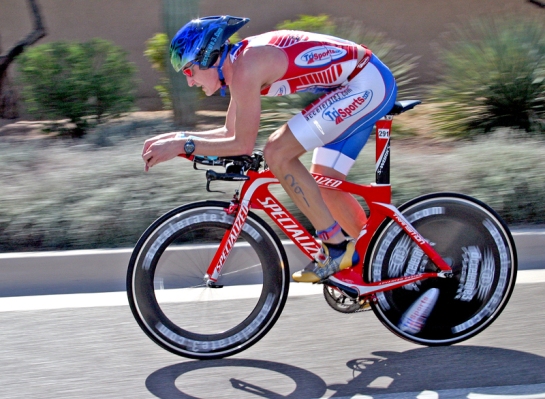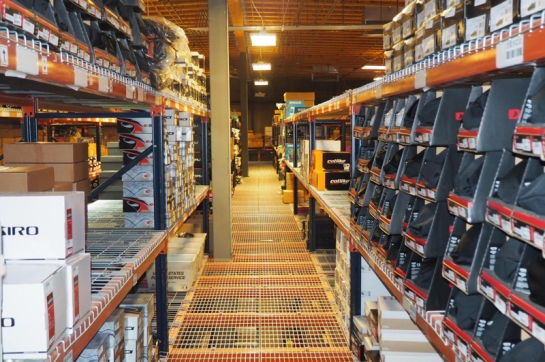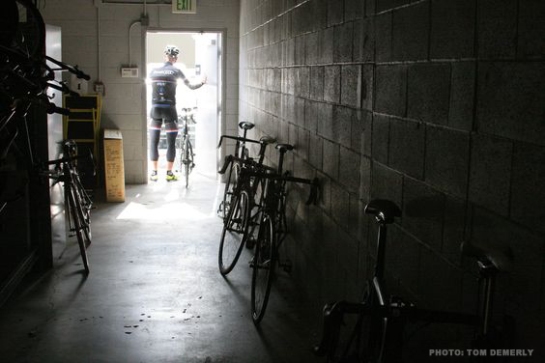By Tom Demerly for tomdemerly.com

1. Preserve Price.
Tim Brick, owner of Brick Wheels, a successful independent bike retailer in Traverse City, Michigan told me years ago: “Never discount. You will only go out of business slower.”
Price preservation and the perception of what a product is worth has been destroyed by weak-kneed and undercapitalized bike retailers who give discounts too easily.
Sometimes they give discounts in the hopes of attracting more business, but discounted business is bad business, and it only earns the retailer a reputation for being a sucker to customers who drive a hard bargain. And soon they all drive a hard bargain.
Retailers also give discounts just to keep the lights on. Don’t do that. Just close the business, declare bankruptcy and get a job. The entire industry has been dragged down by incestuous and incessant discounting that has destroyed price integrity, brand identity and even alienated customers who don’t want to negotiate.
If there is one malignant cancer that pervades the entire retail bicycle industry, it is rampant discounting. The problem is so bad most retailers who do it are in total denial of it.
Bike industry, take one tip from a guy who has both succeeded and failed for four decades in this business: Stop Discounting.

2. Don’t Play Favorites: No Sponsored Athletes, No Club Discounts.
When retailers play favorites with some highly visible athletes and groups through “sponsorships” and discounts, they alienate the rank n’ file average customer who subsidizes the cool girl and guy by paying full price. They train the consumership that through performance and visibility they earn special pricing.
This sends a clear message: Some people are more special than others and price is flexible.
Most importantly, there is no consistent, empirical business metric in small bicycle retail that quantifies how many full-margin additional sales are added to the bottom line by sponsoring anyone. And if you can’t accurately measure a sales promotion, you shouldn’t do it.
Sponsorships of athletes and clubs sends a message of favoritism and exclusion, rewarding persistence in driving pricing down.
Even if a sports marketing campaign were run correctly, as it is at the brand level (not by retail stores) it is extremely time consuming and expensive to manage. One beverage industry metric stated that for every $1 spent on sponsorship to automotive racing, the company budgeted $10 talking about the sponsorship in paid media. No bike retailer can afford the money or time for that. And if they could, they should start a beer brand and sponsor a NASCAR driver.
The most recognizable engagement ring brand, Tiffany’s, has never given a free or discounted sparkler to a Kardashian in exchange for publicity. Instead, news media reports, “Kardashian’s Tiffany Sparkler Was $25M!”. That preserves the perception of value and makes the brand aspirational.

3. Don’t Have Too Much Inventory.
The worst thing about the bike business is bikes, and bike brands ram inventory down retailers’ throats with a vengeance. Bike shops: less is more. It is better to have money in the bank than bikes on the floor.
Bicycle inventory is like fruit, the second it lands it begins to spoil. Something newer, cooler and better is already under development and months away from release. And with the evolution in media the word about upcoming innovations doesn’t spread fast, it spreads instantly. As soon as something new is announced, what is suddenly old (but current only hours before) is suddenly devalued.
Customers will buy new, relevant bikes sight-unseen if the retailer’s sales process is optimized to facilitate that purchase format. That preserves capital, maintains freshness and keeps prices up. It also provides customers with more options and better integrity in the purchase.
Bike shops with a lot of inventory on the floor, and a lot of invoices on their desk, are compelled to “sell what we’ve got” and that leads to an ugly paradigm of putting customers on the wrong size bike with the wrong equipment rather than ordering the right bike and adding another invoice to the pile.
Consumers should be wary of bike shops with too many bikes on the floor, they’re going to try to ram something they have in stock down your throat just to make an invoice due date instead of getting you the bike you should really have.

4. Do Have Lots of Capital.
Nearly every bicycle retailer is undercapitalized and over leveraged financially. The reason is simple: When you have $500K to invest in something, does opening a bike shop provide the highest return on that investment? No, it doesn’t. You could take that $500K to an Edward Jones office and earn a better return on it the next day with no work than if you did the heavy lifting and ditch-digging of opening, promoting and running a bicycle retail store. As a result, most bike retailers try to start a business with about $50-200K and make a go of it.
If they don’t own their own real estate free and clear, have to pay rent or a mortgage, pay at least one employee payroll (and mandatory withholding taxes and health insurance) then the math doesn’t work.
To make bike retail profitable you have to have deep pockets and a deeper work ethic. You have to love hard work and business, not bikes and bike rides.
In its current iteration, the bicycle retail business model is a rotten investment. But, a new, emerging business model long on service and profit margin and short on inventory and overhead is promising and will be the bike shop of tomorrow.
5. Manage Costs.
This doesn’t mean go cheap. If your biggest overhead item is marketing then you are doing it right. If your customers arrive at your store and consistently say, “I thought this place would be a lot bigger”, you’re doing it right.
If you’re biggest overhead item is inventory, you are already in trouble.
Starting and maintaining a bike shop can be done very cheaply. Never buy new fixtures, so many used fixtures from other retailers that have been closed are available they can be had for pennies on the dollar. Never pay for extraneous and non-paying expenses like alarm systems (they won’t prevent or deter theft anyway) and subscriptions to POS software systems. Those don’t add to the bottom line.
Use low-cost, streamlined, highly adaptive and simple systems to combat the asymmetrical retail war the little bike shop has to fight against the big box e-commerce giants. Think of how the Afghan Guerillas used crude weapons to bring the Soviet Union to its knees, and still give the Americans fits in rural Afghanistan. Be a retail guerilla, a retail Taliban. Keep your costs low, adaptable and maintain a large amount of liquid capital.
6. Invest in Star Employees.
The online retailer you compete against is a faceless enemy. You can defeat him with a friendly face. If you have a star employee whom customers consistently ask for, reward them before anything else. Give them raises before you buy more bikes, pay them first and well and craft a set of “golden handcuffs” that makes it tough for them to go anywhere else. They are your brand, and if you lose them, you will have to rebuild your brand around another star employee. Worse yet, if you lose your star employee to another bicycle retailer across town or if your star opens their own shop, guess what happens, their customers follow them.
For a small bicycle retailer, the star employee is the single most important business tool. Develop them, value them, reward them, retain them.
7. Participate in the Sport.
Instead of sponsoring the local hotshot, be the local hotshot. This doesn’t mean you have to do a nine-hour Ironman (but it helps) it just means you have to be present at events and participate credibly. This is a part of your business. It is work.
Set up the hours of your store so you can train. Close on key race weekends so you can be where the action is, as a part of the action. Ride the nicest bike you sell and show it off everywhere. Be an aspirational figurehead so when people see you on social media and in the store you have become “That Guy who Knows Everything and is Everywhere”.
If you build your hours correctly and manage your staff correctly the time you spend in the sport will directly and measurably bring full-price buyers into your store and keep them offline.
8. Differentiate Yourself.
Build a voice, a brand and an identity. If your identity is so lifeless and generic that people confuse your business with others, you haven’t done that.
Understand that you will not please everyone. Nor is that the goal. If you talk about a donation to a wounded veteran’s charity in social media an anti-war activist may stop shopping with you. Fine. You can’t be everything to everyone.
Build your brand with clear vision and narrow focus. Don’t be generic. Don’t appeal to the masses. Keep your brand message narrow, unique and focused and be true to who you are.
If you are gay, fly the rainbow flag in front of your store and sponsor “Pride Rides”. If you are a veteran, have benefits for veteran’s organizations. If you are an animal rights activist, broadcast your donations to the local animal shelter and host an adoption day at your store. If you are an environmentalist, show your commitment to renewable energy and talk about how bikes preserve the environment.
Have the courage and identity to stand for something, be someone different and special. Brand yourself visibly and distinctly.
9. Be Highly Adaptive.
Small bicycle retail is asymmetrical warfare: A small opponent taking on a much larger, better capitalized foe. Take a page from the teachings of Mao Tse Tung, Ho Chi Minh, Fidel Castro, Che Guevara and Osama Bin Laden’s play book: Never fight fair.
Change your floorplan frequently. Bring in small, low-priced, easily purchased new products first. Seek out niche brands the big-box guys don’t have and use the equalizing power of social media to partner with the brand to promote them.
Build a reputation as a brutal buyer who torments sales reps and sales managers with non-adherence to “program” buying. If the biggest brands’ credit manager loves you but the sales manager hates you, you are doing it right.
Within your brand identity continue to change and adapt. Use every social media platform. Embrace new media. Use video. Never stop changing, evolving and promoting. There are two types of businesses on the retail battlefield: the quick and the dead. Improvise, adapt, overcome.
10. Have An Exit Strategy.
One day, this will all end. What will you have to show for it? Did you squirrel away money in an offshore account? Did you buy real estate? Is your brand developed enough to have some sales value? And, if you begin to fail, and chances are overwhelming that you will, do you have a viable safety net?
It’s a pipe dream to sell a small bicycle retail business. Frankly, they aren’t worth anything. The inventory is usually older than six months, the fixtures are stale, the employees may not come with the deal and rest can be reinvented elsewhere better and cheaper. As a result, you have to have a viable exit strategy.
What is yours? What is your end game? When do you cry “Uncle” and walk away? Know those answers in advance and you can sleep more soundly at night as a bike retailer.


























